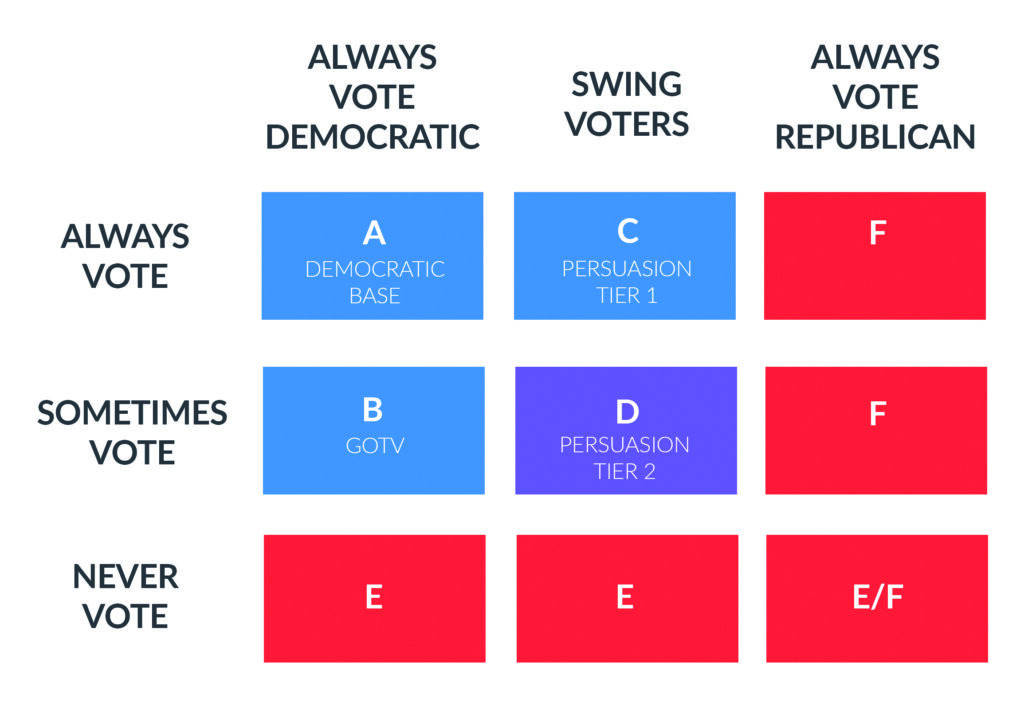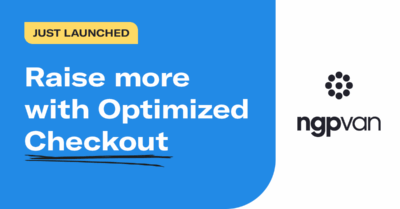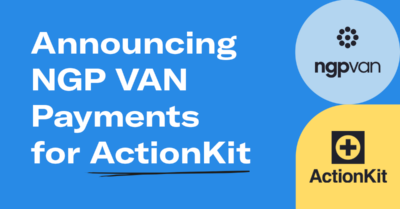Planning a Political Campaign: Guide to Field Organizing

All political campaigns are major undertakings no matter what level of office you’re running for. Whether you’re running for Congress or city council, you will want to create a comprehensive campaign plan to guide everything you do during the busy election season. Of course, developing this plan requires a strong understanding of your voter base, helpful volunteers, and software that can help you manage all the moving parts of your campaign.
To help you gain a better understanding of field organizing and the preparation that goes into it, this guide will explore the basics of political campaign planning, goal setting, and field and supporter engagement tools you may want to use for your campaign.
What is Field Organizing?
Field organizing is the process of directly contacting voters in order to educate and mobilize them toward your campaign’s goals. Field organizing is a critical part of grassroots organizing and voter outreach activities for campaigns and causes nationwide. The main goal of field organizing is to identify supporters and persuade them to get out and vote.
Despite being most heavily associated with the final Get Out The Vote (GOTV) phase, field organizing happens throughout the entire campaign cycle and typically involves tactics such as door-to-door canvassing, phone banking, text banking, and campaign rallies and events. Typically, these efforts are run by a Field Director and a staff of organizers. In addition to those voter outreach strategies, campaigns may also use additional voter outreach methods to contact voters and advertise to them such as direct mail, robocalling, and radio or television ads. While these methods mostly fall outside of how most people define field organizing, they are still valuable ways to contact voters.
Field organizing is a critical part of campaign strategy for races at every level, and common tactics scale to fit a wide range of goals and budgets. At its heart, field organizing seeks to bring a human approach to campaigning, encouraging voters to become politically active through the power of one-on-one conversations with dedicated volunteers. Of course, while human relationships are irreplaceable, successful field organizing also relies heavily on precise data, which guides campaigns to invest their resources in targeted voter outreach.
How Does a Field Plan Fit Into Political Campaigning?
Your campaign plan is your roadmap to success. It’s a comprehensive document of everything your campaign will do from the day you declare your candidacy to planning for the next election.
A strong field plan is one of the most integral pieces of a political campaign plan, providing direction for how you will contact the voters who ultimately decide the result of the election.
Setting Field Goals
Setting field goals for your campaign is a critical step when developing your field plan because you need to know how many voters you need to contact to set your campaign up for success on Election Day. To do that, you’ll need to calculate your win number, target the voters you need to hit your win number, and then start contacting them.
Calculate a Vote Goal or Win Number
While campaigns may want to win in a landslide, they can win with a simple majority (50% of the vote plus one vote). As such, when building your field plan, you will need to calculate your win number. Your win number is based on the number of voters expected to turn out and vote in your race, and the margin of votes needed to win the election. Most campaigns use 50% of the vote plus one vote as their baseline, but others may change their percentage to aim higher than that baseline (e.g., 53% or 55% of the expected turnout).
To determine the expected turnout for an election, campaign strategists typically calculate the average turnout from three past similar elections. To get an accurate prediction, choose elections that are as similar to yours as possible, keeping outlying factors in mind.
A few factors might include:
- General election years typically see higher turnouts than midterm elections.
- Contentious and publicized races tend to see higher turnout.
- Drastic events, like natural disasters, can depress voter turnout.
It’s also important to consider trends in your community’s growth and shifts in demographics, which can impact your final win number. For example, voters under the age of 30 have turned out in record numbers in recent years (especially 2018 and 2022), partially due to significant investments by groups in mobilizing and activating those younger voters.
Strategically Targeting Voters
After calculating their win number, campaigns need to determine which voters to focus their energy on to reach that number. To most effectively use your campaign’s limited amount of time and resources, you’ll want to target the voters you need to win your race rather than targeting all the voters in your district.
To make these decisions, voters are typically divided based on two axes: partisanship and turnout, pictured below.

- The voters in Square A are considered the Democratic base: strong Democrats who are reliable voters.
- Voters in square B are the main target for GOTV efforts. You can count on them to vote for you, as long as they get to the polls.
- Squares C and D are swing voters who need to be persuaded. Specifically, the voters in square D are the most labor-intensive to reach since they need to be persuaded to not only vote for your candidate but to vote at all.
- Voters in the E and F rows will not vote for you and are not worth spending resources on in almost all cases.
Determining how many voters fall into each category requires access to a voter file, which most Democratic campaigns receive access to through the appropriate state party. Using past voting data and modeling within the database, campaigns can determine how many voters within their region fall into each category. From these numbers, it is possible to determine which categories of voters will be required to reach the win number, and what types of resources the campaign will need to invest in.
For example, the Democratic base voters may be few in number, but there may be a substantial group of GOTV voters, suggesting that the campaign’s strategy will focus heavily on turnout. Alternately, the “Always Vote Democratic” column may be small, meaning that the campaign will need to focus its resources on persuading swing voters. Calculating your win number and understanding who you need to vote to hit it will make it easier for you to begin conducting targeted voter outreach.
Tactically Contacting Voters
Now that you have determined your win number and the type of voters you need to reach to hit that number, it is time to put together a voter contact and activation strategy.
The most common methods for contacting voters include:
- Door-to-door canvassing. Door-to-door canvassing allows your campaign to build one-on-one relationships with voters. While it may be one of the more time-consuming voter contact methods, canvassing tends to be most effective at persuading unaffiliated voters.
- Phone calls. Phone banking campaigns are a convenient alternative or supplement to door-to-door canvassing as you can facilitate one-on-one conversations with voters who you may be unable to visit in person or may have missed you during your canvass in their neighborhood.
- Text messages. Texting voters and supporters can be another effective way to help gather more information, generate action, and get out the vote. There are several steps involved in getting set up on a political text messaging service, so if you choose to use this method of voter contact, start setting it up early!
- Direct mail. Direct mail is useful for campaigning in communities where most residents have fixed addresses. For example, you might be able to reach an entire neighborhood at once in a suburban community but find greater success physically handing out fliers in a college town.
- Campaign rallies and events. Events generate excitement among your base, who are the most dedicated and most likely to attend rallies. As such, events and rallies can be an essential part of your GOTV effort by generating excitement among supporters who just need an extra push to make it to the polls.
The tactics used for communicating with your targeted voters depend on a variety of factors, such as budget, geographical constraints, and demographic considerations. For instance, rural areas may be inefficient or impossible to canvass effectively, so you may want to try calling them first. On the other hand, towns with a high population of college students or young people may be more responsive to texting initiatives than traditional phone banking. Figure out what methods work best for your campaign and make the most of them as you continue to optimize other voter outreach methods. Through a multichannel approach, you’ll have a better chance of connecting with the voters you need to win your election.
Field Tools for Political Campaigns
The most important field tool for political campaigns is NGP VAN’s mobile canvassing application MiniVAN.
Before MiniVAN was created, canvassing often involved giant paper packets that were difficult for volunteers to sort through as they navigated from door to door. Then, at the end of a day of canvassing, campaign staff would have to sort through those pages manually entering the data into VAN.
Fortunately, MiniVAN has made it easy for volunteers to have guided conversations with voters, enter survey responses, navigate to each door they’re assigned, and sync data back to VAN for the campaign to act on later in the campaign.
Canvassing Tools
MiniVAN offers many built-in features that make it easier for your volunteers to effectively canvass.
For instance, rather than following a limited linear script, MiniVAN allows you to use branched scripts that guide canvassers’ conversations with voters by programmatically showing the next question on the script based on the answer to the first. MiniVAN also allows campaigns to choose a default script and up to four alternate scripts to easily guide conversations with different groups of voters.
So, if someone indicates they plan to support your campaign, you can ask if they’d be interested in volunteering. But, if they haven’t decided who they’ll support, you can ask about what issues are important to them to try and connect them back to your campaign and convince them to support your campaign.
Phone Banking Tools
Virtual Phone Banks allow campaigns to easily create targeted phone banks that can be shared just with staff and volunteers within VAN or more widely by publishing them to openvpb.com. By creating an Open Virtual Phone Bank (OpenVPB), you can share a link to your phone bank with volunteers, no matter where they are, to have them start making calls. You can also contact more voters faster with VPB Connect, which offers click-to-dial functionality within OpenVPB.
Political Text Messaging Service
Campaigns often send texts to voters and supporters to encourage them to take action for the campaign. Whether your texts are attempting to increase attendance at upcoming events, encouraging people to vote early, or turning out the vote on Election Day, they allow you to quickly contact voters at scale with targeted messages. These messages can then feed data back into your voter database which you can easily act on in the future.
Volunteer and Supporter Engagement Software
All campaigns start by recruiting volunteers and supporters who can help them execute their field plan and achieve other campaign goals. Here are a few tools and platforms you may want to utilize for your campaign to help you engage with your volunteers and supporters.
Volunteer Recruiting Tools
Whether you’re starting out with a large volunteer base or gathering your first supporters, Mobilize can help power your volunteer recruitment efforts.
Through its built-in features and automations, Mobilize has provided up to a 40% increase in event RSVPs from volunteers for activities like canvassing and phone banking.
In addition to its impactful platform features, Mobilize offers a VAN integration that can automatically sync attendance data back to VAN. In VAN, you can also use the Volunteer Management Dashboard to easily scan through valuable volunteer information, reach out to new and existing volunteers, and more. Use Mobilize and VAN together to effectively recruit and manage more volunteers to help achieve your campaign goals.
Donation Processing Software
Collecting donations is essential for keeping your campaign funded and your field operations moving forward. Ensure you have a reliable and easy-to-use donation processor that supporters can access from your website. With a mobile-responsive donation form, your canvassing team can even encourage particularly dedicated supporters to make a donation in the moment during their door-to-door conversations.
Targeted Emailing Tools
Email is a staple for communicating with your base, whether you’re asking people to attend an upcoming canvass or phone bank, requesting donations, or making a request for supporters to get to the polls.
You’ll want to use an email platform that allows you to create targeted emails that will appeal to specific groups of supporters. For example, you might build one email template to highlight upcoming field events (like canvasses or phone banks) and another encouraging your supporters to take their friends with them to vote early.
By using NGP VAN’s email software, you can use our library of pre-created templates to get the word out as quickly as possible to targeted groups of supporters to increase attendance at events, raise money, and more.
Event Management Platform
Events can be helpful for raising awareness, earning donations, and pushing supporters to make the extra effort to vote. Leverage an event management platform that allows you to host both in-person and virtual events to connect with supporters, whether they’re local or remote.
Field Volunteer Management
How you manage your volunteers depends on several factors, including the size of your race or district, how independent and well-trained your volunteers are, and how many (if any) field organizers or staff you have supporting your campaign.
By using a distributed organizing strategy, you can remove some of the administrative weight from your field organizers’ daily workload. This decentralized approach to running a campaign puts power in the hands of your volunteers and enables individual chapters and groups to independently manage themselves.
For example, consider a statewide campaign. The main campaign offices are likely located in highly populated cities, but field organizers understand the importance of winning votes everywhere, including more remote areas. With distributed organizing, they can contact volunteer leaders in those communities, provide them with a list of houses to canvass, and trust them to contact local voters.
Of course, make sure your campaign is still accessible in the event that these volunteer leaders need guidance or run into any issues a more senior member of your campaign should address.
Executing Your Field Plan
Your field plan is your campaign’s roadmap to execute effective voter outreach, and each step in it should guide you to the voters you need to win. Calculate your win number, identify the voters you need to win, execute voter outreach, and get out the vote with NGP VAN’s complete toolkit for Democratic and progressive candidates.



